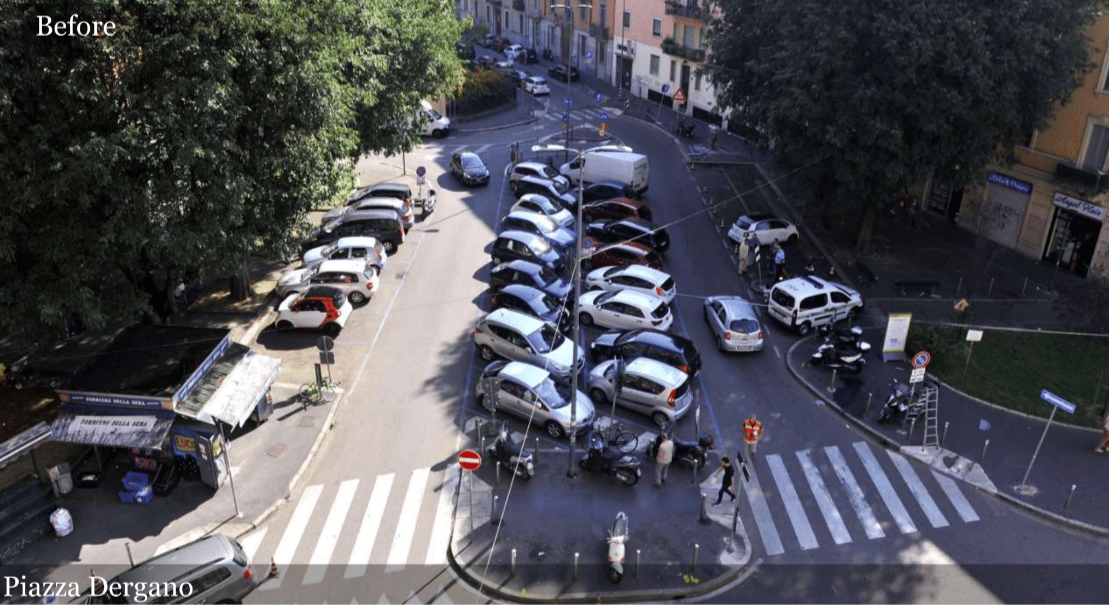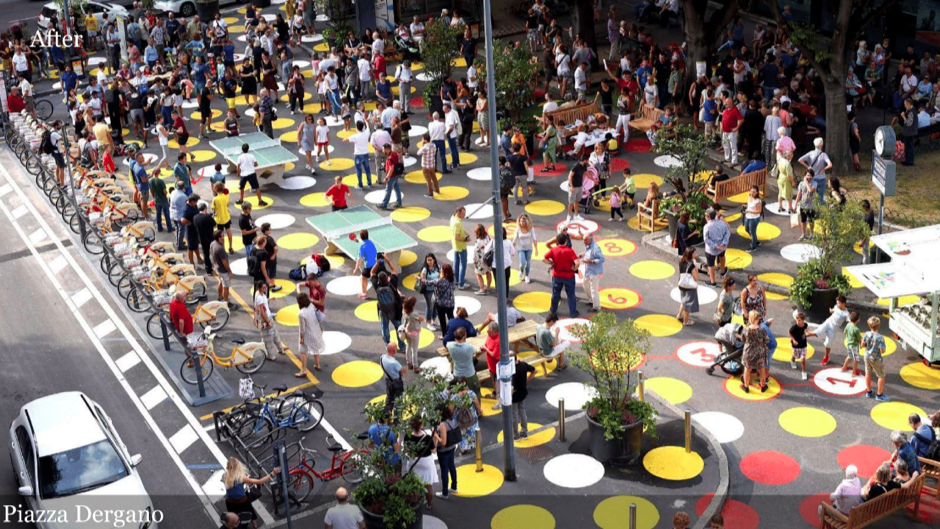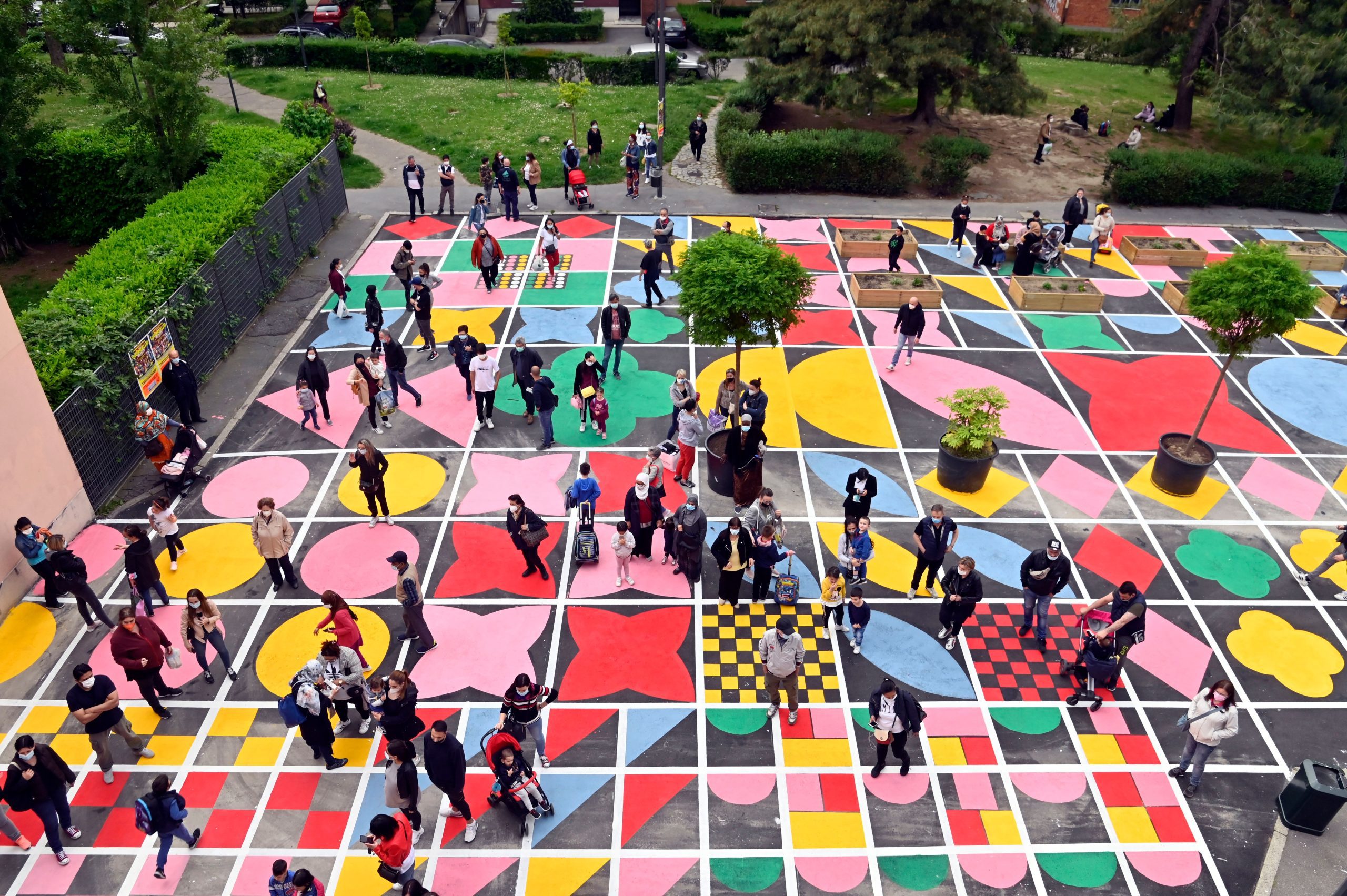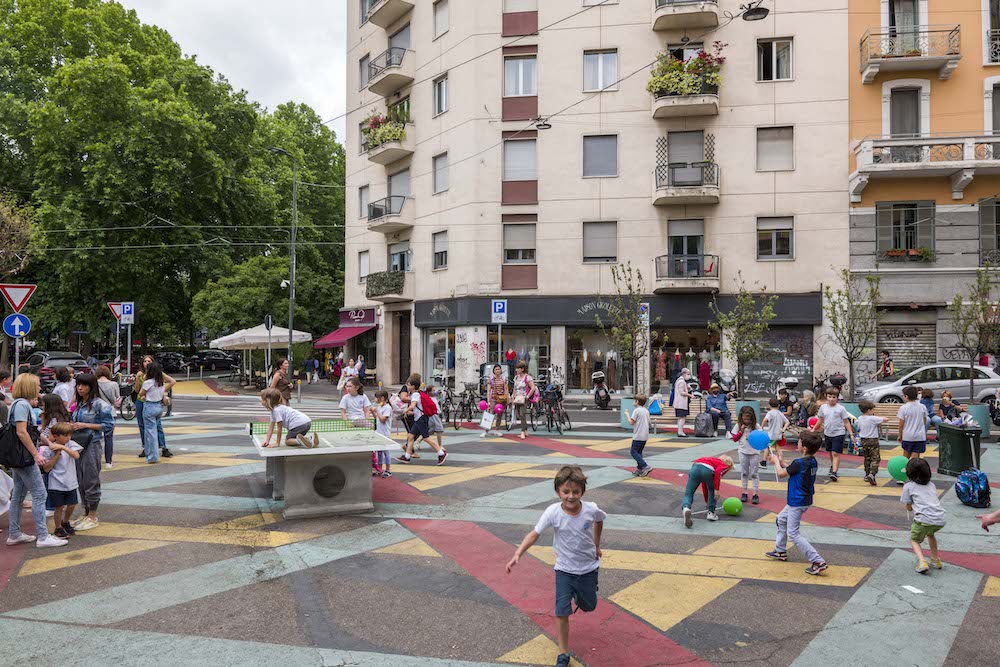In the past years, Milan has become a model city in public space regeneration. The Piazze Aperte (“Open Squares”) programme, launched in 2018 has become a key reference for municipalities and activists aiming at transforming their cities with safer streets, more attractive and more accessible public spaces, more climate-resilient infrastructure and stronger, more compact and liveable neighbourhoods. Piazze Aperte (“Open Squares”) is a program of the City of Milan, developed by Agenzia Mobilità Ambiente Territorio (AMAT) together with Bloomberg Associates and the Global Designing Cities Initiative.
Following the first tactical urbanism interventions, the programme launched an open call to collect over 60 proposals for new public spaces across the city. Piazze Aperte also developed mechanisms for the co-management and maintenance of public spaces. In the past four years, Piazze Aperte has redeveloped 40 public spaces covering over 25,000 m2, with the participation of thousands of citizens, NGOs, associations, schools, religious organisations and businesses. AMAT experts Demetrio Scopelliti and Stefano Ragazzo shared their experiences about Piazze Aperte and the role of Milan’s public space innovation within the city’s broader future vision in Budapest, organised by KÉK – Contemporary Architecture Centre and Eutropian, in the frame of the PLAY/ACT project, with support from the Italian Cultural Institute of Budapest. This article is an edited version of their presentation.
When we talk about cities and changing our built environment, we should realise what everything we do affects the planet. What we are doing to our earth, our planet, is not reversible anymore.

It is a big responsibility. We need to consider that we are living in an urban age when – and it is an increasing trend – up to 70% of people will live in cities. Cities are places where we gather, we work, and cities are places we pollute, where we produce and consume energy. We have to consider that in order to change the way we tackle the planet we have to change our cities. In order to adapt, we need to use tools to mitigate what climate catastrophe has done so far.
A strategy for Milan: a shift from 2030…
Milan, as many other cities in the world, has a plan, a vision. Many cities have a vision: Cophenhagen, Milan, Madrid, Barcelona and also Budapest. All cities have a vision more or less, a vision towards the future. The plan Milan 2030 was conceived the understanding that change needs time. These are plans of transforming, going from consuming to reusing, changing the narrative from grey to green. Talking about neighbourhoods instead of suburbs, and of course, shifting the focus from cars to people. So easy to write it in a vision and put all this together through public space. Public space is a common good, it’s a pillar of all the different strategies the city sets. If it is mobility, environment, social topics, public space is the place. Also public space is the main space that the city has to change the city itself. Of course, half of our cities are streets and streets are public space, it is where we can work to produce change.
…to 2020
And all of a sudden, with the pandemic, everything changed. Our life was disrupted and we were forced to stay at home. The way the city was working also changed. We realised that a crisis, whether it is pandemic or climate, changes the way we live in cities much faster than we thought. We started thinking that maybe the normality we were talking about wanting to go back to is not so normal anymore.
We realised that Milan 2030 is too far. We wrote an adaptation plan based on immediate change, to have a vision for 2020, instead of 2030. This is relevant because just setting visions is not enough. Visioning change and visioning the future are fundamental to generate hope for change. We also need to understand the dissatisfaction about how things are now. But the key to making things change is to make the first step. How to accelerate change? What can we do to make it possible immediately and not in the next years or in a decade?
To change public space we have many instruments such as public works. Every time you touch the sidewalk, that is public works. You change the pavement, you widen it, everything related to this costs millions of euros, the process is incredibly long due to all the bureaucratic procedures. You appoint someone, you go to the design process, change the project, gain political approval, if you don’t get it, change the design again… there are so many phases. When everything seems to be done, after three years of work, there are issues, like the people who were supposed to do the work are not available anymore, and it is a mess. Sometimes public work takes five, six or even eight years to finish. The issue is that everything that we do ends up with an irreversible status. You spend millions and it takes years until it is done. There are no designers who do not make mistakes. How bad is spending public money and spending years doing something that at the end is not perfect or not as radical as it could be towards change?


Testing and Reversibility
In 2018 we asked ourselves: why don’t we shift to another mode of operating things? We have public works and we will continue to do so. But why don’t we test? Why don’t we try? We can show some results immediately and see how certain ideas work. We can tell people who are asking for change that they don’t have to wait six years. Basically we take the tactical urbanism logic, a bottom-up process, and try to make it institutional.
It is a methodology that gives you the possibility to change places in months with just a few thousand euros and with solutions that are completely reversible. Reversibility is key. When you say that you change the sidewalk, there will be someone in the room who will say no and resist because they want car parking spaces instead. Resistance is everywhere. The issue is how to deal with resistance by showing that you can go back. Reversibility means you can go back, make things reversible, saying, if it doesn’t work, we go back and change things as they were. So far there has been no need to go back to a previous state because most of the resistance disappeared a few months after the implementation.
The process starts from a place that was not satisfactory, like a car park; turning it into an interim place and then making it permanent. When you make it permanent you are almost sure that it works, and you make people realise the experience works. You don’t have to convince them because they are living the change and engaging in the change.
Tools: Volunteers, toolkits, collaboration pacts
We have a simple was to turn public spaces around. In all our projects, we use the most simple tools that are very effective though they are the cheapest ones that we can get from the city. The technical toolkit is very simple. Street marks, the same as the ones used for dividing parking lots, are used as a design tool. Most of the time people helping the design process are local volunteers from the neighbourhoods. If we don’t have enough young people from the neighbourhood we try to get other volunteers from the platform of the Municipality of Milan where people can apply and be part of this volunteer process but most of the time it is people from the neighbourhood.
We use street marks both for defining the new viability scheme and for colouring the new pedestrian area. We use paint which is the cheapest tool and solution. It’s an incredibly powerful design tool and it’s a day’s work to do the actual painting! One of the key moments of the urban transformation is the collective transformation of the space.

In some cases we involve artists to make the pavement change appearing as a public art experiment. We introduce bollards and cubs because in Milan you have to protect people and space from other people driving cars. It is a strange psychological issue to think about. We want to make the streets alive and social. For this, we find that there is no better tool than a ping pong table but we are open for other suggestions. That is an incredibly powerful moment when people from the neighbourhoods take the space, start using it, making it alive. We then make a collaboration pact with the volunteers stating who is responsible for the painting, the activation, the maintenance. It makes them responsible for the change they are asking for. We organise events and parties. Parties are key: if you want people to accept a place, just make them have a party there.
Involving citizens in transformation: an open call
This toolkit brought us to deliver three programmes in four years. The first in 2018 in collaboration with Bloomberg Associates and the Global Designing Cities Initiative. We started a series of pilot projects. The collaboration with Bloomberg was key for us to learn from their expertise, other cities and to secure more political support. We said “let’s try to do two pilots and let’s see what happens.” The two pilots worked so we did more of them. We convinced people in the municipality of this potential methodology to change the space in the city. When we were ready to say that “we can now do more, we are aware of what works and what does not,” we announced an open call for citizens to apply and asked them to be part of the change. We didn’t ask them where they wanted to have a new public square but how they wanted to be part of the collaboration project to transform the piazza. We thought we would get maybe ten proposals. In reality, in two months we got more than 1000 people, bodies and entities applying across the city. So they were not just inhabitants but were made up of 200 NGOs, local associations, social groups, shops, shop associations, schools, and religious institutions. We received 65 proposals in two months and we realised 40 of them. There are more under approval and under development.
Where are these spaces? They are not in the city centre as we don’t need that much more pedestrianised spaces in the city centre. We need to extend the idea towards the neighbourhoods, to have a plaza in each neighbourhood. We found different typologies of projects. The most interesting ones are the new plazas which reclaim public space from the streets. We also did projects in underused spaces which we wanted to activate. Sometimes we work on extending the curbs to develop safety measures, as there are 30 people in Milan dying every year because of car crashes.

Interventions at the scale of the city and the neighbourhood
Our first project was Piazza Dergano. It was a car park with 25 cars parked there 90% of the time while some benches under the trees were incredibly alive and used, so we saw a potential for change and started to consider transforming it into a proper plaza. The project process took six months with a three-week implementation period. The opening party was a turning point because we showed people, including politicians, that change can be done immediately. You just need to want to do it.
Another of our earlier projects was Piazzale Stazione Genova which is at a railway station, a square at the city’s scale and not a local space. Inside the station was fine but as you stepped out you were in a traffic jungle. The process was really complicated with many difficulties as we had public transportation such as trams with rails which is very tough to deal with. We learned that as long as we have a strong local association, inhabiting, taking care of the space, that square will have a good and structured development whereas if a space doesn’t have a specific community but is inhabited by many users, this scale is hard to transform just through tactical urbanism. We learned that tactical urban intervention fits better with the local scale.
We did other pilots as well, such as one in a . Cars here can do any kind of manoeuvre, go left or right, crossing, turning. There are no official car parks but there are cars parked everywhere, a typical 21st century image of our cities. There is a grey barrier, containing children when they enter and exit from school, protecting them from cars. We, people, contain our children but allow cars to do everything. We need to change our perspective. Why don’t we show people in the neighbourhood that the space is key for people, not cars? All the photos we have of these projects showing everyday life demonstrates that people need these spaces to be there. It was a great success and it showed we needed to do more.

To give an example about transforming commercial spaces, we learned that working with a weekly market is tough, as it involves commercial interests. It took a longer time, but we succeeded in adding a ping pong table by moving one seller to another place. Without testing this space we would never have the possibility to sit at a table at a commercial management and say, can we move one seller to add some furniture? Next year you can ask for another change. Step by step you transform the situation. Otherwise if you start from scratch they would never agree.
Children and the space in front of schools
We realised the schools are a fantastic environment for these experiments. We did a lot of projects with schools. Now the next phase of the project is going ahead: we are launching now the second open call, Piazze Aperte for Every School.
If you want to change public space, make it liveable for children: they are the future. We need to educate people, that it is fantastic to have children playing instead of car parks. I love the moment we start implementing the changes and we look at the space and see the reactions. The children say “mom, there are no cars anymore!” and when we start painting they go crazy and start running around as they always wanted to run around but they couldn’t. They want to be free but they cannot. This is really unnatural. It is an easy win from the side of the municipality and parents are really involved.

Learning from Piazze Aperte: adapting to the pandemic
These are not all we did. This methodology was very helpful in the pandemic when the streets were empty and allowed us to imagine allocating space differently. In less than a year we developed 67 km of bike lanes, spending less than what we used to spend in a year to develop just one kilometre of bike lane. The city is the same, you don’t need to invest millions to change the city: it is better to test and then change.
Another project focused on a major axis at the Corso Buenos Aires. We showed with this project that a very busy commercial axis at a peak hour can host more bikes than cars if you have a bike lane. We are talking about a simple bike lane, just painting a line on the street and moving the car park to protect the space. In two years we saw the use of cars and other modes decreasing from 75% to 49%, while bike use increased from 5%to 10% and this number is just going to increase, this is a trend: at some point bikes will overcome drivers. We have been on TV and in newspapers for a year with this project; if you want your project to be alive just put a line on the street and you become famous.
Last but not least during the pandemic we also needed space to keep the shops alive when it was not possible to go inside. Why don’t we use the car parks, the redundant spaces? You can transform a parking space into a fantastic terrace. It generates local economy, vibrancy, and safety. We transformed 1000 parking lots into “streateries” in a year and we tested some solutions such as shared spaces with a speed limit of 15 km/h. Then we realised that some of these spaces could be pedestrianised and we went along with that.
Streets are key for urban change
Piazze Aperte was an experience of over three years. The key message of this process is that if you work in a city or for a city, the main space for change is streets. Because streets are the most public spaces we have. When you consider streets as public space you should change your perspective from cars to people. When you have in mind that streets are for people and people can become part of a community, the only thing you have to do is make the community a changemaker, empower people to support you to change the city. Because they ask for change. The issue is that we always listen to the ones resisting.
This article is an edited version of a presentation given by AMAT experts Demetrio Scopelliti and Stefano Ragazzo given in Budapest, on 21 October 2022, organised by KÉK – Contemporary Architecture Centre and Eutropian,


